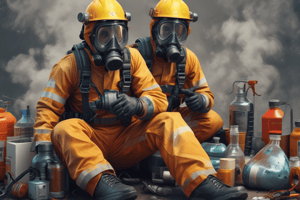Podcast
Questions and Answers
What is chemical risk?
What is chemical risk?
- The duration of contact with a chemical substance
- The ability of a chemical to cause harm
- The potential for a chemical substance to cause harm to human health or the environment (correct)
- The amount of a chemical substance that is absorbed or ingested
What type of chemical risk is associated with exposure to high concentrations of a chemical?
What type of chemical risk is associated with exposure to high concentrations of a chemical?
- Toxic risk
- Chronic risk
- Acute risk (correct)
- Environmental risk
What affects the amount and duration of contact with a chemical substance?
What affects the amount and duration of contact with a chemical substance?
- Dose
- Exposure (correct)
- Toxicity
- Individual susceptibility
What is the first step in chemical risk assessment?
What is the first step in chemical risk assessment?
What is the goal of risk reduction in managing chemical risks?
What is the goal of risk reduction in managing chemical risks?
What is the relationship between the dose of a chemical and the resulting health effects?
What is the relationship between the dose of a chemical and the resulting health effects?
Flashcards are hidden until you start studying
Study Notes
Definition of Chemical Risk
- Chemical risk refers to the potential for a chemical substance to cause harm to human health or the environment.
Types of Chemical Risks
- Acute risks: Short-term risks from exposure to high concentrations of a chemical, potentially causing immediate harm or death.
- Chronic risks: Long-term risks from exposure to low concentrations of a chemical, potentially causing harm or disease over an extended period.
Factors Affecting Chemical Risk
- Exposure: The amount and duration of contact with a chemical substance.
- Toxicity: The inherent ability of a chemical to cause harm.
- Dose: The amount of a chemical substance that is absorbed or ingested.
- Individual susceptibility: Variations in people's sensitivity to chemical substances.
Chemical Risk Assessment
- Hazard identification: Identifying the potential for a chemical to cause harm.
- Dose-response assessment: Determining the relationship between the dose of a chemical and the resulting health effects.
- Exposure assessment: Estimating the amount of chemical exposure to a population or individual.
- Risk characterization: Combining the above steps to estimate the overall risk posed by a chemical substance.
Managing Chemical Risks
- Risk reduction: Implementing measures to reduce the risk of chemical exposure, such as using personal protective equipment (PPE) or substituting hazardous chemicals with safer alternatives.
- Risk communication: Informing people about the risks associated with chemical substances and providing guidance on safe handling and use.
- Regulatory controls: Establishing laws and regulations to limit the use and exposure to hazardous chemicals.
Chemical Risk
- Chemical risk is the potential for a chemical substance to cause harm to human health or the environment.
Types of Chemical Risks
- Acute risks are short-term risks from exposure to high concentrations of a chemical, potentially causing immediate harm or death.
- Chronic risks are long-term risks from exposure to low concentrations of a chemical, potentially causing harm or disease over an extended period.
Factors Affecting Chemical Risk
- Exposure refers to the amount and duration of contact with a chemical substance.
- Toxicity is the inherent ability of a chemical to cause harm.
- Dose refers to the amount of a chemical substance that is absorbed or ingested.
- Individual susceptibility refers to variations in people's sensitivity to chemical substances.
Chemical Risk Assessment
- Hazard identification involves identifying the potential for a chemical to cause harm.
- Dose-response assessment determines the relationship between the dose of a chemical and the resulting health effects.
- Exposure assessment estimates the amount of chemical exposure to a population or individual.
- Risk characterization combines the above steps to estimate the overall risk posed by a chemical substance.
Managing Chemical Risks
- Risk reduction involves implementing measures to reduce the risk of chemical exposure, such as using personal protective equipment (PPE) or substituting hazardous chemicals with safer alternatives.
- Risk communication informs people about the risks associated with chemical substances and provides guidance on safe handling and use.
- Regulatory controls establish laws and regulations to limit the use and exposure to hazardous chemicals.
Studying That Suits You
Use AI to generate personalized quizzes and flashcards to suit your learning preferences.




